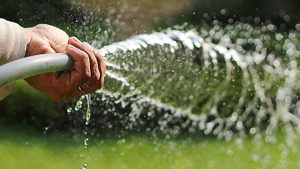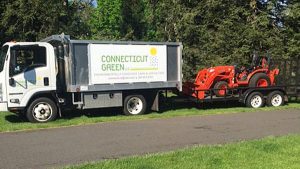It’s that time of year – time to seed the lawn and cross your fingers, hoping for a lush, green lawn. There are many factors that affect seed germination, the process during which the seeds absorb moisture and sprout. Many of those factors are totally out of our control, but there’s a lot you can do to ensure the success of germination, and ultimately, the health of your lawn for the season.
The most important factor impacting seed germination is moisture. The seed has to absorb enough through its hull to start sprouting. If there’s too much moisture, the seed can rot. If there’s too little, it will dry out. Both the thickness of the hull (which varies, depending on the variety of seed) and the ground temperature will play a role here, along with how much water Mother Nature and you provide.
Watering
Your most importantly role in this early phase of grass growth is to keep the ground moist at all times during germination, which can last form 5-30 days, depending on the type of grass. If you overwater, you don’t only risk rot, you risk washing the seeds away entirely. Five to ten minutes of regular watering should be enough to keep things growing.
Temperature
You can’t control the ground temperature, but it’s important for you to understand how it factors into germination. Depending on what type of grass you choose, the temperature of the ground needs to be between 45-65 degrees. (In Connecticut, we’ll generally stay on the cooler side.) The ground needs to stay at the same approximate temperature for the entire germination period. Fragile grass seeds will die if there’s an extreme change in the environment, whether that means a heat wave or a deep freeze. This is one of those areas you can’t control, but make every effort to plan appropriately. Keep in mind – ground temperature will always be cooler than air temperature! For us, the best time to seed when it’s about 60 degrees.
Remember Photosynthesis?
You learned in biology that seeds need oxygen to grow, right? Remember all that business about photosynthesis? Well, it’s true: grass seed, like every other plant, needs air to grow. That’s one key reason to be sure you don’t overwater and drown your seeds. Compacted soil also restricts air circulation, so the best environment for grass seed to grow is a lawn that’s been aerated. (We talk about the benefits aeration quite a bit on our blog!)
Sunlight is also critical for photosynthesis, but grass seedlings can’t achieve that until they’ve broken through the earth. That means your seeds shouldn’t be planted too deep – they won’t be able to produce food for themselves until they break the surface and catch some rays.
Watch for Hazards!
Many people have concerns that birds will eat all their grass seed. We have never, ever seen birds destroy a freshly-seeded lawn. Please don’t worry if you see them picking away at the seed – it will be fine! It is, however, critical to keep kids and pets off your germinating lawn. These are the biggest external risks to germination.
Table of Germination Times for Common Grasses from The Spruce:
- Annual ryegrass: 5-10 days
- Hard fescue: 7-14 days
- Kentucky bluegrass: 14-30 days
- Perennial ryegrass: 5-10 days
- Red fescue: 7-14 days
- Tall fescue: 7-12 days
You’ll see that there’s a pretty broad range of germination times. However, once your grass seed germinates, the growth will be pretty quick!
Got more questions about grass seed germination? Send them our way!





